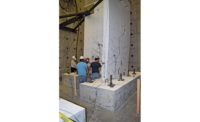"Design strength and ductility issues need to be resolved," among other issues, says Kelly. The research also will confirm long-held assumptions about 60-ksi rebar that were based on judgment or past practices, rather than research, adds Heintz.
The report lists an estimated budget for each study or test. The biggest chunk of money—an estimated $16.9 million—would be for seismic design research.
There are a handful of makers of high-strength steel. Each one has to get its product tested and approved for use, which can be costly and time-consuming.
"It is better that the industry coordinate the research effort so that there is a generic product," says structural engineer Ramon Gilsanz, a principal of Gilsanz.Murray.Steficek LLP and a member of the ATC 115 review panel.
The research is "very important," according to Gilsanz. "Other countries, including Japan, are way ahead of us."
In the U.S., high-strength rebar has been used on a limited basis for several years. An early use was in a 31-story residential project, called Escala, in highly seismic Seattle (ENR 8/27-9/3/07 p. 10).
Since 2010, the New York City Dept. of Buildings has allowed limited use of high-strength bars, through Buildings Bulletin 2010-003.
For projects outside New York City, engineers must secure approval on a case-by-case basis, which takes longer and is at the discretion of the building official. "If high-strength rebar was in the code, approval would come from [meeting] the code rather than building-by-building approval," says Vincent DeSimone, chairman of DeSimone Consulting Engineers, which has used high-strength rebar in high-rise projects in Miami. "I think [the research] is an excellent effort," he adds.
Using high-strength rebar, engineers can keep member sizes the same, easing rebar congestion, or reduce member sizes, using the same amount of rebar.
As a rule of thumb, five 1.4-in.-dia Grade 60 bars can be replaced by one 2.5-in.-dia Grade 97 bar, says Jaime Silva, chief operating officer for SAS Stressteel Inc., the U.S. arm of a German maker of the 97-ksi rebar.
In a typical high-rise, using SAS's 97-ksi rebar to replace 60-ksi bar where appropriate, the cost of installed rebar is 20% to 30% less due to decreased tonnage, says Silva. This accounts for a 20% material-cost premium. High-strength rebar in the code will open up the market, increase demand and production, and, likely, lower the material cost, adds Silva.
Pankow plans to create several coalitions to finance the research projects. "We will spend the next year putting the coalitions together," says Mark J. Perniconi, Pankow's executive director.







Post a comment to this article
Report Abusive Comment